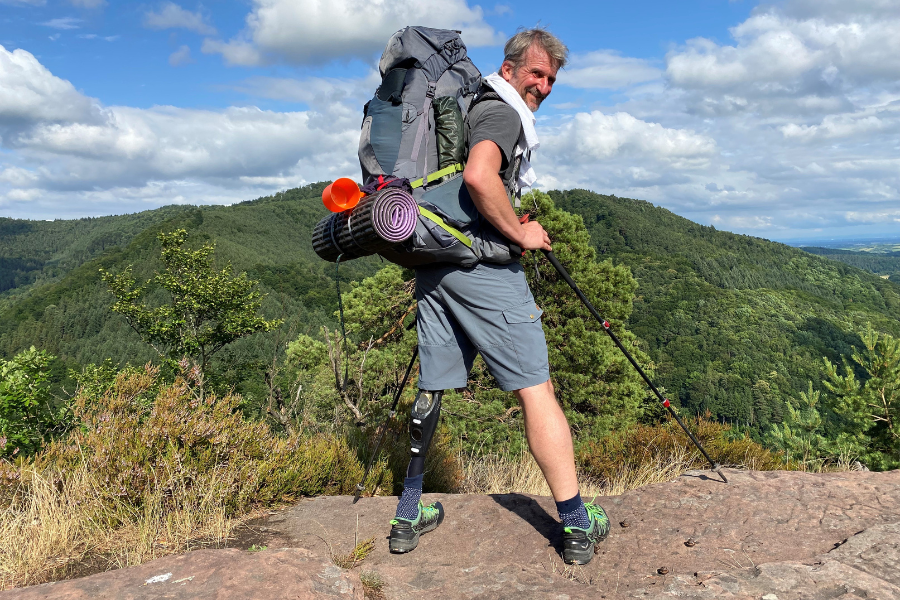
Summertime is travel time. And while many are looking forward to the holiday, fears and worries mix with the anticipation of some prosthesis wearer. Because traveling with a prosthesis can be unsettling for people who have recently had an amputation or are traveling with a prosthesis for the first time. But - and here's the good news - it doesn't have to be that way. With a little preparation, appropriate planning and a few tips from the community, every trip can be managed with a prosthesis.
So here are my personal tips for preparing for your next trip.
A few weeks before the trip
There are several points that travelers with a prosthesis - especially those who are inexperienced - should think about before the actual start of the trip. Because in my experience, good preparation helps to take the stress out of the travel days, so that you can approach and enjoy the tour in a relaxed manner.
- In my opinion, an important part of the preparation is to know as precisely as possible what to expect on the trip - especially on long distance trips. In this way I can identify possible obstacles and challenges and think about how I want to deal with these obstacles and challenges.
- Regardless of the type of trip, it is generally good to ensure that you have a prosthesis passport. It is a document that shows that you are a prosthesis wearer, which model you are using and some other data about the device. Such a document can help with security checks at the airport or on some trains (such as the Eurostar).
- The same applies to other documents from your technician or doctor if you are carrying other aids or certain medications.
- A note: When taking medication with you, please always check whether the ingredients are legal in the country you are traveling to. If this is not the case, then no medical document will help. This is especially important for THC/CBD oils and similar preparations.
Air travel
- If a flight is part of the trip, check which assistance is offered and report your need in good time. For example, you can get earlier boarding, an aisle seat, or help with boarding and disembarking.
- In my opinion, it is also helpful to find out about the airports used for the trip. In some places, the distances between gates or terminals are long (sometimes extremely long). This can pose problems for some prosthesis wearers. Here you can also make use of assistance if necessary and should plan enough time.
- In my experience, security checks are one of the things that scare most of prosthesis wearers. And the range of experiences is wide: from completely unproblematic to degrading and outrageous. Since all prostheses probably trigger the safety alarm, we are usually checked separately. So please plan enough time here.
- In theory, people with disabilities are entitled to be examined in a private area. However, this is rarely the case, especially at many smaller airports in countries of the Global South. If you have concerns, feel free to talk to other travelers in advance and find out more.
- In some countries/at some airports it is possible to register for security checks. The US Transport Security Administration, for example, has such a service.
- Another point is the luggage. It is difficult to make a general statement here. For example, you can take crutches with you as special medical luggage. It is best to get information from the airline.
Other means of transport
- Many of these points are also applying to train travel. A lot of train stations are not handicapped accessible; many platforms can only be reached via stairs. The same applies here: inform yourself well in advance and plan enough time.
- It is also important to know that for many of us, the super narrow toilets on airplanes or coaches are a real challenge.
- Regardless of whether you are traveling by plane, train or bus: Many of us find it difficult to sit for long periods in mostly narrow seats. Sometimes even small pillows or something similar help to sit more comfortably and free of discomfort. For some of us, the question arises as to whether the prosthesis can be removed. This is something to consider when traveling by air, as the residual limb may react in an unusual way, for example increases in volume. It may then be very difficult to put on the prosthesis shortly before landing. So, think about taking a compression sock or liner with you.
Accomodation
- If you are dependent on accommodation that meets the needs of people with disabilities, you are definitely looking for it anyway. Here it is advisable to name the needs as precisely as possible and to have them confirmed by the hotel, guesthouse, etc. Not everyone understands 'disabled room' or 'easily accessible sanitary facilities' in the same way.
- Not only in terms of accommodation itself, but also regarding any aids that may be needed on site, it is good to communicate clearly (and bring things yourself if necessary). First and foremost for us amputees, it is the shower stool.
- If you are going to distant regions where the power supply could be a problem, then it is definitely advisable to obtain detailed information and to take any precautions in terms of overvoltage protection for the charger - or, if possible, always charge from a power bank. Modern microprocessor prostheses are very susceptible to overvoltage.
- In addition, many modern prostheses are not waterproof - which can be a problem in tropical regions. Even within a city, a street can be quickly flooded after a rainstorm. It helps to always have a light waterproof bag (like those used by kayakers) with you. If necessary, it can be quickly pulled over the prosthesis.
Prosthesis check
- Before each trip, please check in good time that your residual limb is in good condition. Travel and the associated stress factors for the body often have an effect on the residual limb. In addition, it is always advisable to carry some remedies with you to deal with any skin problems, minor miracles, increased sweating etc.
- The same applies to the prosthesis. It is best to have the technician check it again before the trip and take one or the other spare part with you. Above all, there is a spare valve, liner, sealing lip, socks, as well as adhesive tape and a small tube of silicone. Your technician can give you specific advice here.
- If you're going to more remote regions or if you're traveling for a longer period of time, I always find it helpful to find out about any local orthopedic care. More and more manufacturers of prostheses are now offering a corresponding service. Often, they can tell you in which countries you can expect professional help - and in which not.
That sounds like a lot of points, but a lot of it is easy to do, some only apply to long-distance travel, and other things exist due to individual personal preferences when traveling. Don't let that put you off.
If you want to read more or look at other checklists, you will find a lot of good information on the Ottobock homepage (click here ).
The week before the trip
Now the start of the journey is slowly approaching. Much of what I do about a week before the start of my trip follows logically from the points mentioned above.
- Take care of registering the required assistance at the airport, airline or train station.
- Think about what clothes you want to wear for the trip. Especially if you sit for a long time on an airplane, train or bus, the fit of the prosthesis may no longer be ideal, and you will have to improve it after getting up. Loose clothing helps with this. Loose clothing also makes it easier to show the prosthesis at the security check. The same applies to shoes that are easy to put on and take off.
- Put together a small carry-on bag with a spare valve, lotion, possibly blister plasters and other things that will help you on long trips. If available, the USB charger and a full power bank can also be put in here.
- If you might want to take a pillow or other support with you to sit better, have that ready as well.
- Make sure you have the plug adapter(s) ready for your trip.
- If you tend to get stressed and very excited in new and unfamiliar situations, think about what music or book/audio book helps you to stay/become calm. Have this ready and refer to it during the flight/drive.
- If you have a prosthesis that relies on electricity, fully charge it the day before you travel (to help the battery last longer, some prostheses can also be put into deep sleep mode for long trips).
The day of the trip
- Start with enough time and don't give unexpected delays a chance to degenerate directly into stress.
- Mask off areas on the stump that may be particularly affected by sitting for a long time or rub milk fat/lotion on them.
- If necessary, ask for help and gladly accept the help offered.
- For the next trip, remember what works and is helpful and what you would like to do differently next time.
- Have a good time and enjoy the journey - and if things don't go well, smile, relax and take a deep breath. With composure and creativity, most challenges that people with disabilities experience when traveling can be easily overcome.

So, I hope the rather extensive list helps you to prepare for the next trip. I would also be happy to hear from you what other tips you have when it comes to preparing for trips with disabilities.
If you have any questions or ideas about traveling with a prosthesis, contact Björn directly in the forum !